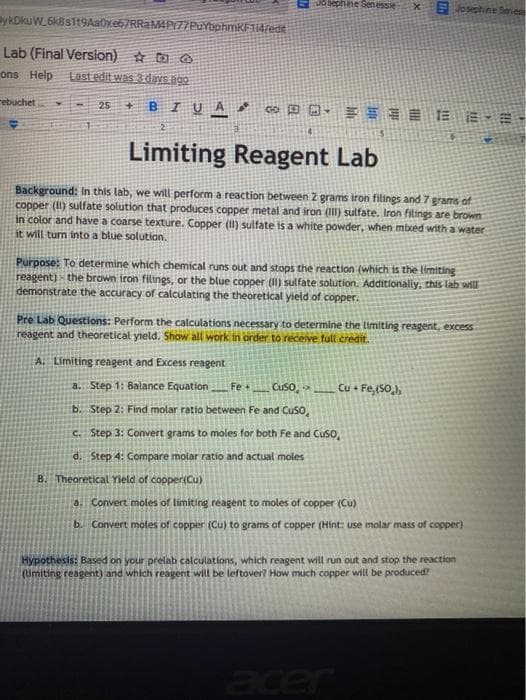Ine Senessie X Josephne Se ykDkuW 6k8sIt9AaOxe67RRaMAPI7PUYophmRETi4redt Lab (Final Version) D O ons Help Last edit was days ago rebuchet 25 + BIUA Limiting Reagent Lab Background: In this lab, we will perform a reaction between 2 grams tron filings and 7 grams of copper (II) sulfate solution that produces copper metal and iron (Il) sulfate. Iron fitings are brown in color and have a coarse texture. Copper (I) sultate is a white powder, when mixed with a water it will turn into a blue solution. Purpose: To determine which chemical runs out and stops the reaction (which is the limiting reagent) the brown iron filings, or the blue copper (II) sulfate solution. Additionalily, this lab will demonstrate the accuracy of calculating the theoretical yield of copper. Pre Lab Questions: Perform the calculations necessary to determine the timiting reagent, excess reagent and theoretical yield. Show. all work in order to receive full credit. A. Limiting reagent and Excess reagent a. Step 1: Balance Equation . Fe + _ CusO, -» _ Cu + Fe,(SO,), b. Step 2: Find molar ratio between Fe and Cuso, C. Step 3: Convert grams to moles for both Fe and Cuso d. Step 4: Compare molar ratio and actual moles B. Theoretical Yleld of copper(Cu) a. Convert moles of limiting reagent to moles of copper (Cu) b. Convert moles of copper (Cu) to grams of copper (Hint: use molar mass of copper) Hypothesis: Based on your prelab calculations, which reagent will run out and stop the reaction (Umiting reagent) and which reagent will be leftover? How much copper will be produced?
Ine Senessie X Josephne Se ykDkuW 6k8sIt9AaOxe67RRaMAPI7PUYophmRETi4redt Lab (Final Version) D O ons Help Last edit was days ago rebuchet 25 + BIUA Limiting Reagent Lab Background: In this lab, we will perform a reaction between 2 grams tron filings and 7 grams of copper (II) sulfate solution that produces copper metal and iron (Il) sulfate. Iron fitings are brown in color and have a coarse texture. Copper (I) sultate is a white powder, when mixed with a water it will turn into a blue solution. Purpose: To determine which chemical runs out and stops the reaction (which is the limiting reagent) the brown iron filings, or the blue copper (II) sulfate solution. Additionalily, this lab will demonstrate the accuracy of calculating the theoretical yield of copper. Pre Lab Questions: Perform the calculations necessary to determine the timiting reagent, excess reagent and theoretical yield. Show. all work in order to receive full credit. A. Limiting reagent and Excess reagent a. Step 1: Balance Equation . Fe + _ CusO, -» _ Cu + Fe,(SO,), b. Step 2: Find molar ratio between Fe and Cuso, C. Step 3: Convert grams to moles for both Fe and Cuso d. Step 4: Compare molar ratio and actual moles B. Theoretical Yleld of copper(Cu) a. Convert moles of limiting reagent to moles of copper (Cu) b. Convert moles of copper (Cu) to grams of copper (Hint: use molar mass of copper) Hypothesis: Based on your prelab calculations, which reagent will run out and stop the reaction (Umiting reagent) and which reagent will be leftover? How much copper will be produced?
Organic Chemistry: A Guided Inquiry
2nd Edition
ISBN:9780618974122
Author:Andrei Straumanis
Publisher:Andrei Straumanis
Chapter5: Resonance
Section: Chapter Questions
Problem 18E
Related questions
Question

Transcribed Image Text:Ine Senessie
X Josephne Sonese
ykDkuW 6k8s1t9AaOxe67RRaMAPITIPuYbphmRETi4/edt
Lab (Final Version) * D O
ons Help
Last edit was devs ngo
rebuchet
25+
BIUA
Limiting Reagent Lab
Background: In this lab, we will perform a reaction between 2 grams tron filings and 7 grams of
copper (II) sulfate solution that produces copper metal and iron (Il) sulfate, Iron fitings are brown
in color and have a coarse texture. Copper (I) sulfate is a white powder, when mtxed with a water
it will turn into a blue solution.
Purpose: To determine which chemical runs out and stops the reaction (which is the limiting
reagent) the brown iron filings, or the blue copper (II) sulfate solution. Additionaly, this lab will
demonstrate the accuracy of calculating the theoretical yield of copper.
Pre Lab Questions: Perform the calculations necessary to determine the timiting reagent, excess
reagent and theoretical yield. Show.all work in order to receive tull credit.
A. Limiting reagent and Excess reagent
a. Step 1: Balance Equation . Fe + _ CusO, -» _ Cu + Fe,(SO,),
b. Step 2: Find molar ratio between Fe and Cuso,
C. Step 3: Convert grams to moles for both Fe and Cuso
d. Step 4: Compare molar ratio and actual moles
B. Theoretical Yleld of copper(Cu)
a. Convert moles of limiting reagent to moles of copper (Cu)
b. Convert moles of copper (Cu) to grams of copper (Hint: use molar mass of copper)
Hypothesis: Based on your prelab calculations, which reagent will run out and stop the reaction
(Umiting reagent) and which reagent will be leftover? How much copper will be produced?
Expert Solution
This question has been solved!
Explore an expertly crafted, step-by-step solution for a thorough understanding of key concepts.
This is a popular solution!
Trending now
This is a popular solution!
Step by step
Solved in 2 steps with 2 images

Knowledge Booster
Learn more about
Need a deep-dive on the concept behind this application? Look no further. Learn more about this topic, chemistry and related others by exploring similar questions and additional content below.Recommended textbooks for you

Organic Chemistry: A Guided Inquiry
Chemistry
ISBN:
9780618974122
Author:
Andrei Straumanis
Publisher:
Cengage Learning

Organic Chemistry: A Guided Inquiry
Chemistry
ISBN:
9780618974122
Author:
Andrei Straumanis
Publisher:
Cengage Learning